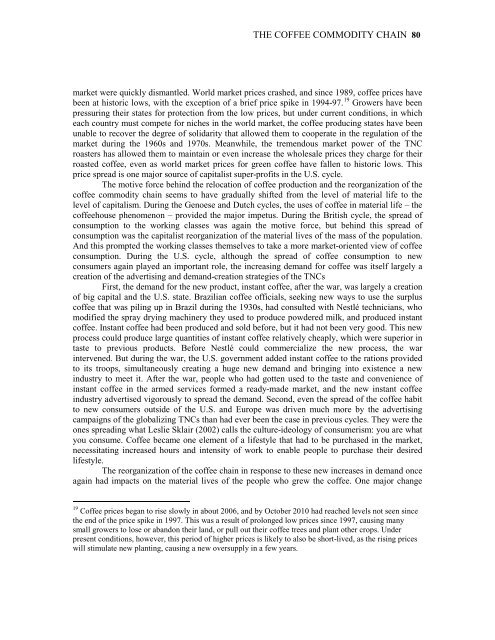Entire Volume 17 issue 1 - Journal of World-Systems Research ...
Entire Volume 17 issue 1 - Journal of World-Systems Research ...
Entire Volume 17 issue 1 - Journal of World-Systems Research ...
You also want an ePaper? Increase the reach of your titles
YUMPU automatically turns print PDFs into web optimized ePapers that Google loves.
THE COFFEE COMMODITY CHAIN 80<br />
market were quickly dismantled. <strong>World</strong> market prices crashed, and since 1989, c<strong>of</strong>fee prices have<br />
been at historic lows, with the exception <strong>of</strong> a brief price spike in 1994-97. 19<br />
Growers have been<br />
pressuring their states for protection from the low prices, but under current conditions, in which<br />
each country must compete for niches in the world market, the c<strong>of</strong>fee producing states have been<br />
unable to recover the degree <strong>of</strong> solidarity that allowed them to cooperate in the regulation <strong>of</strong> the<br />
market during the 1960s and 1970s. Meanwhile, the tremendous market power <strong>of</strong> the TNC<br />
roasters has allowed them to maintain or even increase the wholesale prices they charge for their<br />
roasted c<strong>of</strong>fee, even as world market prices for green c<strong>of</strong>fee have fallen to historic lows. This<br />
price spread is one major source <strong>of</strong> capitalist super-pr<strong>of</strong>its in the U.S. cycle.<br />
The motive force behind the relocation <strong>of</strong> c<strong>of</strong>fee production and the reorganization <strong>of</strong> the<br />
c<strong>of</strong>fee commodity chain seems to have gradually shifted from the level <strong>of</strong> material life to the<br />
level <strong>of</strong> capitalism. During the Genoese and Dutch cycles, the uses <strong>of</strong> c<strong>of</strong>fee in material life – the<br />
c<strong>of</strong>feehouse phenomenon – provided the major impetus. During the British cycle, the spread <strong>of</strong><br />
consumption to the working classes was again the motive force, but behind this spread <strong>of</strong><br />
consumption was the capitalist reorganization <strong>of</strong> the material lives <strong>of</strong> the mass <strong>of</strong> the population.<br />
And this prompted the working classes themselves to take a more market-oriented view <strong>of</strong> c<strong>of</strong>fee<br />
consumption. During the U.S. cycle, although the spread <strong>of</strong> c<strong>of</strong>fee consumption to new<br />
consumers again played an important role, the increasing demand for c<strong>of</strong>fee was itself largely a<br />
creation <strong>of</strong> the advertising and demand-creation strategies <strong>of</strong> the TNCs<br />
First, the demand for the new product, instant c<strong>of</strong>fee, after the war, was largely a creation<br />
<strong>of</strong> big capital and the U.S. state. Brazilian c<strong>of</strong>fee <strong>of</strong>ficials, seeking new ways to use the surplus<br />
c<strong>of</strong>fee that was piling up in Brazil during the 1930s, had consulted with Nestlé technicians, who<br />
modified the spray drying machinery they used to produce powdered milk, and produced instant<br />
c<strong>of</strong>fee. Instant c<strong>of</strong>fee had been produced and sold before, but it had not been very good. This new<br />
process could produce large quantities <strong>of</strong> instant c<strong>of</strong>fee relatively cheaply, which were superior in<br />
taste to previous products. Before Nestlé could commercialize the new process, the war<br />
intervened. But during the war, the U.S. government added instant c<strong>of</strong>fee to the rations provided<br />
to its troops, simultaneously creating a huge new demand and bringing into existence a new<br />
industry to meet it. After the war, people who had gotten used to the taste and convenience <strong>of</strong><br />
instant c<strong>of</strong>fee in the armed services formed a ready-made market, and the new instant c<strong>of</strong>fee<br />
industry advertised vigorously to spread the demand. Second, even the spread <strong>of</strong> the c<strong>of</strong>fee habit<br />
to new consumers outside <strong>of</strong> the U.S. and Europe was driven much more by the advertising<br />
campaigns <strong>of</strong> the globalizing TNCs than had ever been the case in previous cycles. They were the<br />
ones spreading what Leslie Sklair (2002) calls the culture-ideology <strong>of</strong> consumerism: you are what<br />
you consume. C<strong>of</strong>fee became one element <strong>of</strong> a lifestyle that had to be purchased in the market,<br />
necessitating increased hours and intensity <strong>of</strong> work to enable people to purchase their desired<br />
lifestyle.<br />
The reorganization <strong>of</strong> the c<strong>of</strong>fee chain in response to these new increases in demand once<br />
again had impacts on the material lives <strong>of</strong> the people who grew the c<strong>of</strong>fee. One major change<br />
19 C<strong>of</strong>fee prices began to rise slowly in about 2006, and by October 2010 had reached levels not seen since<br />
the end <strong>of</strong> the price spike in 1997. This was a result <strong>of</strong> prolonged low prices since 1997, causing many<br />
small growers to lose or abandon their land, or pull out their c<strong>of</strong>fee trees and plant other crops. Under<br />
present conditions, however, this period <strong>of</strong> higher prices is likely to also be short-lived, as the rising prices<br />
will stimulate new planting, causing a new oversupply in a few years.





